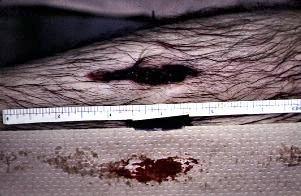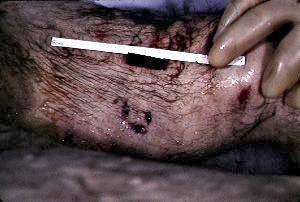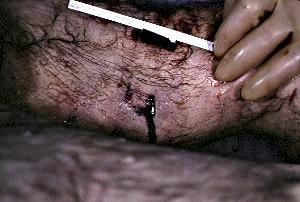Introduction:
Imprints depicting the various wounds that had been inflicted on the Man of the Shroud include numerous dumbbell-shaped scourge marks over the trunk, an exact pattern of rivulets of blood on the left arm, a single tortuous flow of blood on the forehead, a precise bifurcation pattern on the back of the hand and a small clump of blood on the heel. Studies of these patterns with ultraviolet light are even more vivid in terms of preciseness; the scourge marks show well defined borders and fine scratch-like markings appear to be mingled in-between.
The controversy as to whether or not the Man of the Shroud was washed prior to being placed on the burial cloth has far reaching significance in terms of authenticity of the Shroud of Turin. The concept that the crucified was not washed prior to being placed on the Shroud would not be readily acceptable by the forensic pathologist whose expertise includes studies of antemortem and postmortem blood flow patterns. Acceptance of the hypothesis that the crucified was not washed would therefore place the authenticity of the Turin Shroud in serious jeopardy.
It is the purpose of this paper to provide a scientific basis for the hypothesis that the Man of the Shroud had been washed prior to placement on the Shroud. In addition, important facets of scripture and Jewish customs will be discussed.
The Scourge Wounds
If the deceased individual had not been washed, these well-defined wound patterns depicted on the Shroud could not be present. First of all, most of the blood within the scourge wounds of the victim would have been clotted and the blood located both at the periphery and outside of the wounds would have dried long before the victim was placed on the cross.
According to the experiments of Lavoie et al., a cloth would have to be placed on a moist clot no later than 2 ½ hours after bleeding stopped ( 5 ). In addition, these authors indicate that moistened clots have to be transferred within an hour for a good mirror image transfer to take place.
Forgetting all of the other wounds, no one would argue that the scourge wounds were made and clotting begun several hours prior to death. Moreover, most forensic experts agree that the Man of the Shroud shows evidence of rigor mortis because of the bent knees and absence of a neck, therefore indicating that the crucified was dead for some time before being taken down from the cross. Thus, according to the studies of Lavoie's group, these perfectly defined wounds should not have transferred at all. Yet many of the scourge wounds on the Shroud of Turin are extremely distinct corresponding to dumbbell shaped wounds. Even if the clots from these wounds satisfied the time and moisture criteria postulated by Lavoie's group, the shape of the scourge wounds including the bloody areas around the wounds would be indistinct and extremely variable in size and shape depending on the depth of the wound, the angle of the wound, the amount of blood flow, the flow pattern and whether or not clothing was adherent to the wounds. Moreover, even if the dripping sweat of the crucified softened some of the dried blood in areas just outside these wounds, only indistinct and variable-shaped impressions would result. However, if the body was washed, the dried blood around the wounds would be removed causing an oozing of bloody material within the wounds resulting in the production of relatively good impressions of the wound. In order to test this hypothesis, pieces of linen and paper towels were gently touched (not pressed) against wounds from accident victims who lived for several hours following the accident. Relatively no impressions were made. This was repeated after the wounds were rinsed with water and allowed to soak on the wounds for several minutes. Only indistinct bloody impressions were made. The wounds were then washed and this procedure tried again. This resulted in reasonably good impressions of the wounds ( Fig. 1 ).
 |
Figure 1
Hand Wound
An excellent example of the lack of understanding regarding blood flow patterns derives from the so called "double flow" blood pattern presumed to represent two positions assumed by the crucified in order to breathe on the cross, referred to as the Asphyxiation or Suffocation Theory ( 1 ). After extensive experimentation, this theory was recently shown to be untenable ( 10, 11 ). However, even if this asphyxial hypothesis were true, logical reasoning from the forensic point of view would preclude the acceptance of two distinctly defined flow patterns to signify the two presumed positions for breathing hypothesized by Barbet ( 1 ). First of all, the pattern is located on the back of the hand where it is compressed against the cross beam (patibulum) of the cross by nailing. Since the crucified's heart is beating, blood would constantly extrude from this area during every agonizing movement causing a large blood smudge around both the nail and the wound, all over the back of the hand and probably down the arm. Moreover, even if the two well defined blood flow patterns were located on the front of the wrist where smudging would not occur, they could not be attributed to the two alleged breathing positions because the blood flows would have to run into each other causing a pooling of blood due to the various positions assumed by the crucified on the cross and the degree of raising and lowering would not be exactly the same each time. What then would account for the peculiar bifurcation pattern on the back of the hand? The most logical explanation for this pattern may be explained by the formation of rivulets of blood running to the two sides of the u1nar styloid protuberance (the bump on the back of the wrist on the little finger slide) after removing the nail from the wrist sometime after removal from the cross. A case in mind in support of this involved the homicidal shooting of a young man who received multiple gunshot wounds. During the autopsy, I noted the presence of two dried blood rivulets running from a gunshot wound located in the forearm just above the wrist to both sides of the u1nar styloid protuberance. I then realized that the gunshot wound in point was the one I had probed at the scene the evening before in an effort to determine the trajectory. This probing had disturbed the dried blood and the act of removal of the body by the morgue attendants from the scene to the Medical Examiners Office caused the blood to flow to this area. Therefore, a similar mechanism would account for the bifurcation pattern of the hand wound on the Shroud. In order to demonstrate flow patterns, wounds from accident victims who lived for several hours following an accident were briefly washed and observed for oozing of blood. Within a few minutes, a small rivulet of blood appeared ( Figures 2 and 3 ).
 |
Figure 2
 |
Figure 3
There is another experiment that supports my contention that the bifurcation pattern of the hand wound could not be explained by a raising and dropping position of the crucified in order to breathe. Experiments using volunteers suspended on an accurate cross, revealed a bending of the elbows with no change in the angle of the wrist when the volunteers attempted to raise their body ( 11 ). In the case of actual crucifixion, this would even be more striking since a square nail passing tightly through the tendinous areas between the bones of the wrist and then embedded into the patibulum would affix the hand and wrist solidly assuring no change in angle.
Role of the Forensic Pathologist
The expertise concerning blood flow patterns is in the area of forensic pathology. The forensic pathologist is frequently called in to court to provide expert testimony regarding blood flow patterns and wound characteristics and to render an opinion regarding the mechanism, manner and cause of death, concerning these circumstances. This applies to the Man of the Shroud who was apparently scourged, crowned with thorns, nailed through the hands and feet with large square nails and suspended by the hands for several hours.
A forensic evaluation of the crucifixion reveals that every movement during the entire time the crucified was on the cross would have restarted bleeding in the hand and foot wounds. The body unquestionably would have been literally covered with blood because the heart pumps about 4500 gallons of blood through more than 60,000 miles of large and small blood vessels throughout the whole body each day. Instead of the very exact imprints of the wounds, the Shroud would instead bear large indistinct masses of blood over the entire image including the face, arms, hands, feet and trunk. Every practicing forensic pathologist knows that even tiny wounds may bleed profusely during heart activity and observes the end results of bleeding from wounds of practically every type on a daily basis.
In this regard, I recall a recent case in point where a victim nicked a tiny vein with a small carving knife and went to bed believing she would bleed to death. Blood was located everywhere; on her face, neck, torso, hair, and all over the bed linen. She awoke to find that she was still alive and proceeded to kill herself by another means. Her whole body was literally covered with blood. It is also important to realize that for a significant period of time prior to death, there would be very little blood flow from the wounds because the shock state would have caused marked hypotension in the crucified individual.
It is also of importance to note that scourge markings were made many hours prior to removal from the cross so that encrusted clots would have formed in the wounds therefore making it difficult to understand how the scourge marks would have left such precise imprints. Every forensic pathologist that I consulted with, agreed that the wounds would have caused a large amount of bleeding, and the body had to be washed to account for the preciseness of the wounds. In the December 1980 issue of Medical World News, Dr. Michael Baden, a forensic pathologist and the former Chief Medical Examiner of New York City agreed that if the Shroud is genuine, the body must have been washed. He also added that if the body was washed there might be some oozing from the wounds ( 7 ).
Scripture and Jewish Burial Customs
At the outset, it must be realized that my conclusions that the Man of the Shroud was washed prior to placement on the Shroud is solely on a scientific basis. The following thoughts regarding scriptural support are presented with the full realization that I am not an expert in this area.
However, my intention in presenting the following scriptural comments is merely an attempt to show that there is scriptural support for the washing hypothesis. Ian Wilson's presumption ( 9 ) that many scriptural scholars believe Jesus was washed because they based their assumption on the passage from St. John's Gospel "They took the body of Jesus and wrapped it with spices and in linen cloths following the Jewish burial customs (John 19:40)" is obviously correct because the passage is completely straight forward and clear in its interpretation. The evidence in favor of burial according to Jewish burial customs includes St. John's Gospel (John 19:40), the Lost Gospel of Peter (sec. 6) indicated below, the strong probability of an object (shard) such as a coin over the eyes, the use of burial spices (John 19:39), and the wrapping in a shroud (19:40). Rabbi Dan Cohn Sherbok of the University of Kent in England related that it was a legal obligation not only to enshroud the body but to wash and anoint it as well even on the sabbath ("Jewish Shroud of Turin", Expository Times, 1981). However, Wilson's statement that "Only on the view that Jesus was not washed can the authenticity of the Shroud of Turin be upheld" basing it on the fact that there was not enough time to perform the washing since the Sabbath was at hand is completely untenable. A complete washing of the body accompanied by a shortened ritual can be accomplished in minutes.
A piece of controversial scriptural evidence although not accepted by all religious scholars concerns The Lost Gospel According to Peter, section 6 ( 8 ) which is hereby submitted because of its definitive statement regarding the fact that Jesus was washed prior to being placed on the shroud: "And he took the Lord and washed him, and rolled him in a linen cloth, and brought him to his own tomb, which was called the Garden of Joseph." This parchment codex was excavated in 1886 by the French Archaeological Mission when they excavated the grave of a monk in the Valley of the Upper Nile on the right bank of the river in the town of Akemin which was called Panopolis. Historically, religious scholars recognized the existence of such a gospel. For example, reference to such a document was made in 190 A.D. by Serapion, Bishop of Antioch, in 253 A.D. by Origen, and in 300 A.D. by Eusebius, Bishop of Caesaria. In 455, Theodoret indicated in his Religious History that the Nazarines used The Gospel According to Peter. The "Stone of Unction" related by Wilson ( 9 ) that had been recognized since the Byzantine era and presently preserved in the Church of the Holy Sepulcher believed to be the stone on which Jesus was washed and anointed. Moreover, many scriptural scholars have attested to the washing of the body prior to burial ( 6 ). Lavoie et al. ( 4 ) presents an excellent review of the Jewish Law regarding burial customs presently and as far back as the 16th century. Although, the major tenets of the laws regarding burial customs at the time of Jesus were perhaps essentially the same as they are today, we do not know whether there were fine differences practiced today that were not practiced at the time of Christ's death. If we, however, must plug in some scientific justification for washing based on these modern practices, then I submit that the only blood flow after death included a small amount of a watery, blood tinged discharge that extruded from the lance wound. The amount of watery effusate and blood exuding from the lance wound had to be small because immediately upon the introduction of the spear into the chest cavity, the lungs would collapse (pneumothorax) due to the increased atmospheric pressure thereby causing the fluid level to immediately drop because there would now be more space in the chest cavity. Therefore, the only fluid extruding out of the wound would be due to the initial penetration by the lance (immediately prior to collapse) and the small amount of blood from the right atrium of the heart contained on the spear tip by a quick, jerking motion following the sudden thrust. In my opinion, this amount is less than the quarter log quantitated as the minimum amount of blood after death that is required to become unclean according to the Mishna and Talmud ( 4 ). All of the other blood on the body prior to washing would have been present prior to death and could be washed according to the Jewish prescription. If a rapid burial ceremony was necessary, the washing ritual could be effected in a few minutes. The body could then be washed in a few minutes.
Even if more than a quarter log extruded from the lance wound, the small amount of blood around the spear wound could easily be avoided during the washing procedure. The act of washing would then cause an oozing from each of the wounds thereby accounting for the imprints at their locations consistent with those on the Shroud. The blood that oozed from these wounds could not be subsequently washed because this is considered unclean blood. This would therefore conform to the requirements of Jewish Law, account for the well defined wounds depicted on the Shroud of Turin, and provide an explanation that would satisfy the practicing forensic pathologist.
REFERENCES
- Barbet, P., Doctor at Calvary, P.J. Kennedy & Sons, New York, 1953.
- Haas, N., Anthropological Observations on the Skeletal Remains from Giv'at haMivtar , in: Discoveries and Studies in Jerusalem, Israel Explor. J., 20:38-49, 1970.
- Heller, J.H. and Adler, A.D., Blood on the Shroud of Turin, Applied Optics, 19: 2742-2 744, 1980.
- Lavoie, B.B., Lavoie, G.R., Klutstein, D. and Regan, J., The Body of Jesus was not Washed, According to the Jewish Burial Custom , Sindon, 30: 1929, December 1981, Turin, Italy.
- Lavoie, G., Lavoie, B.B., Donovan, V.J. and Ballas, J. S., Blood on the Shroud of Turin: Part 11 , Shroud Spectrum International, Sept. 1983, pp. 2-10.
- O'Rahilly, A., The Burial of Christ, Irish Ecclesiastical Record, Vol. 59, 1941.
- Rhein, R.W. Jr., The Shroud of Turin: Medical Examiners Disagree, Medical World News, 21:40-50, Dec. 22, 1980.
- The Lost Gospel According to Peter, in: The Lost Books of the Bible and the Forgotten Books of Eden, Fount Religious Prayerbook Ser., Collins Pub]. Cleveland, 1948.
- Wilson, I., The Shroud of Turin, the Burial Cloth of Jesus Christ?, Lange Books, Garden City, New York, 1979; Ch. 5, pp. 53-57 and Notes & Ref., Ch. 5, p. 302.
- Zugibe, F.T., The Cross and the Shroud-A Medical Inquiry into the Crucixion. Paragon House Publ., 1988.
- Zugibe, F.T., Death by Crucifixion, Can. Soc. For. Sci. J., 17: 1-13, 1984.